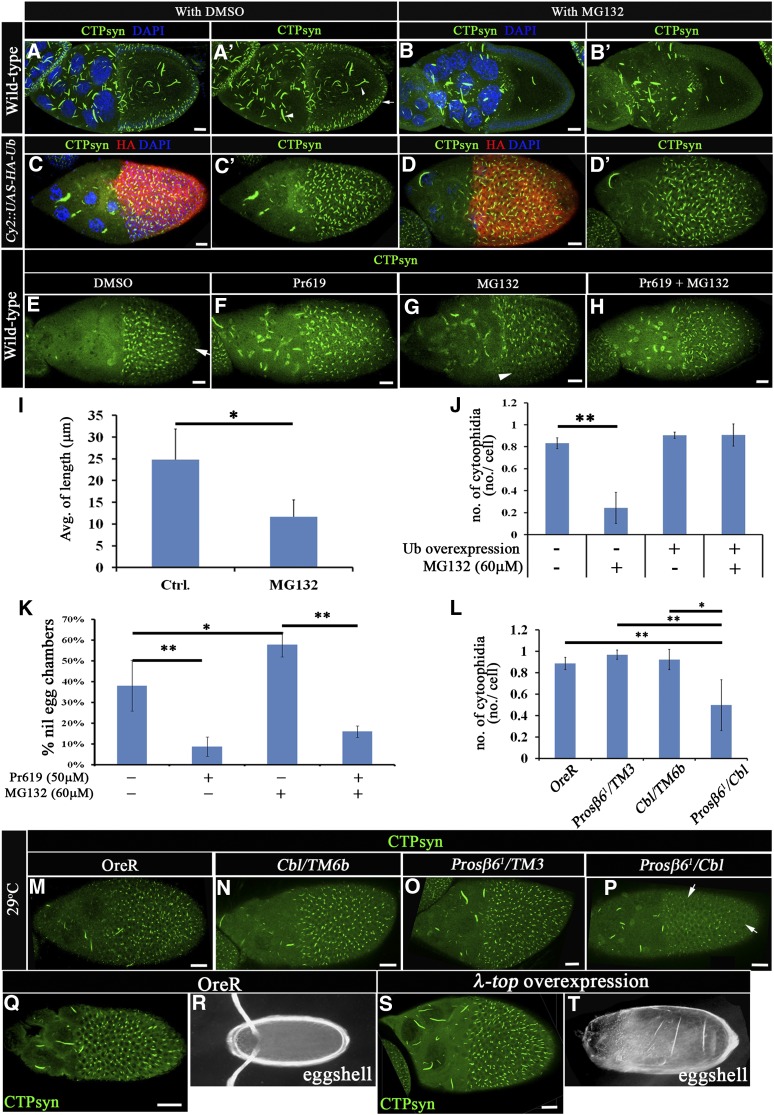Figure 1.
The proteasome degradation system is involved in the regulation of CTPsyn filaments. (A–B′) Merged-multiple confocal cross sections of middle-stage egg chambers stained with anti-CTPsyn antibody (green) and DAPI (blue). Macro-cytoophidia are presented in germline cells (arrowhead), and CTPsyn filaments are shown in somatic cells (arrow). Wild-type egg chambers were treated with DMSO (as a control, A–A′) or 60 μM of the proteasome inhibitor MG132 (B–B′). The average length of macro-cytoophidium was calculated after DMSO (control, 24.83 ± 7 μm) or 60 μM MG132 (11.67 ± 3.89 μm) treatment, and results are shown in I (n = 10 egg chambers, three biological replicates). (C–H, M–P, Q, and S) Merged multiple confocal surface sections of middle-stage egg chambers were stained with anti-CTPsyn antibody (green). (C–D′) Exogenous HA-ubiquitin-expressing (red) egg chambers were treated with DMSO (C–C′) or 60 μM MG132 (D–D′). The average number of CTPsyn filaments is shown in J (16, 51, 6, and 13 egg chambers for columns 1–4, respectively, with ∼140 follicle cells counted in each egg chamber). On average, the numbers of CTPsyn filaments/cell presented in DMSO- and MG132-treated wild-type egg chambers were 0.8 ± 0.5 and 0.24 ± 0.14, respectively. And the numbers of CTPsyn filaments/cell presented in DMSO- and MG132-treated HA-Ub-expressing egg chambers were 0.9 ± 0.03 and 0.9 ± 0.1, respectively. Wild-type egg chambers were treated with DMSO (E, affected region, arrow), MG132 (G, affected region, arrowhead), Pr619 (F), and MG132 plus Pr619 (H). The percentage of egg chambers showing nil phenotypes was calculated and is shown in K (191, 200, 180, and 187 egg chambers for columns 1–4, respectively, in three biological replicates). (M–P) Wild-type egg chambers (M), CblF165/TM6b (N), Prosβ61/TM3 (O), and Prosβ61/CblF165 (P, affected region, arrow) were incubated at a nonpermissive temperature (29°). The average number of CTPsyn filaments is shown in L (cells/egg chambers: 1255/5, 853/5, 1764/5, and 1021/5 for columns 1–4, respectively.). (Q) Wild-type and (S) λ-top-overexpressing egg chambers. (R and T) Eggs laid by wild-type females (R) or females carrying λ-top-overexpressing egg chambers (T). The results are shown as the mean ± SD; *P < 0.05 and **P < 0.01. Bar, 20 μm.

